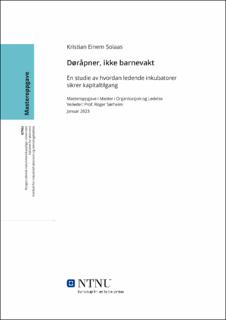| dc.contributor.advisor | Sørheim, Roger | |
| dc.contributor.author | Solaas, Kristian Einem | |
| dc.date.accessioned | 2023-05-24T17:19:17Z | |
| dc.date.available | 2023-05-24T17:19:17Z | |
| dc.date.issued | 2023 | |
| dc.identifier | no.ntnu:inspera:134654924:55947501 | |
| dc.identifier.uri | https://hdl.handle.net/11250/3068884 | |
| dc.description.abstract | Tilgang på risikokapital er en forutsetning for fremveksten av hurtigvoksende teknologiselskaper. Disse støttes ofte av en inkubator – en organisasjon satt opp med ressurser og metoder som hjelper selskapet i etablerings- og vekstfase. Det finnes omfattende litteratur som beskriver hovedmekanismer og innhold i inkubatorer, herunder litteratur som identifiserer kapitaltilgang som et tema i relasjonen mellom inkubator og vekstselskap. Det det mangler derimot litteratur som beskriver inkubatorens verktøy og metoder innenfor spesifikke områder av inkubatorens støtte til vekstselskapet, herunder hvordan inkubatoren bidrar til sikring av kapitaltilgang. Dette er et viktig tema fordi tilgang på risikokapital er en av de mest kritiske faktorene i unge vekstselskapers liv. Dette studiet viser hvordan inkubatorer benytter nettverk av investorer, egen investeringsvirksomhet og egen kompetanse for sikring av kapitaltilgang for sine porteføljeselskap. Studiet bygger på de etablerte begrepene brobygging og avlastning, og introduserer undermekanismer av disse i lys av kapitaltilgang. Studiet viser hvordan brobygging og bygging opptrer i flere variasjoner i inkubatoren og porteføljeselskapets arbeid med oppkapitalisering, og at skjerming sjelden eller aldri benyttes i dette øyemed. Studiet foreslår også hvordan inkubatorens utvalgsstrategi kan utformes for optimalisering av portefølje for kapitaltilgang, og viser at inkubatorens spesifikke humankapital innen investorspørsmål er kritisk for suksess. Studiet oppsummerer med at ledende inkubatorer som lykkes med kapitaltilgang oppnår dette gjennom en selvforsterkende effekt drevet av aktive investornettverk, høy humankapital innen kapitalprosesser, og egen investeringsvirksomhet hvor inkubatoren selv er en aktiv investor i egne porteføljeselskap. Studiet gir anbefalinger på når de forskjellige undermekanismene bør benyttes, og hva inkubatorer bør prioritere i forbedring av sitt arbeid med kapitaltilgang. Studiets utvalg er ledende norske inkubatorer finansiert av Siva SF, hvor disse allerede lykkes innenfor området. Undermekanismene som identifiseres kan sees på som basis for videre forskning på andre fagområder inkubatorer arbeider med, og som et grunnlag for kvantitativt arbeid som kan kartlegge effekten av de forskjellige undermekanismene i kontekst av porteføljeselskapets kapitaltilgang. | |
| dc.description.abstract | Access to risk capital is a pre-condition for the emergence of fast-growing technology companies. These companies are often supported by incubators - organizations equipped with resources and methods that help the company in its establishment and growth phase. There is extensive literature that describes the main mechanisms and content of incubators, including literature that identifies access to capital as a theme in the relationship between incubator and growth company. However, there is a lack of literature that describes the incubator's tools and methods within specific areas of the incubator's support to the growth company, including how the incubator contributes to securing access to capital. This is an important theme because access to risk capital is one of the most critical factors in the lives of young growth companies. This study shows how incubators use networks of investors, own investment activities and own expertise to secure access to capital for their portfolio companies. The study is based on the established concepts of bridging and buffering and introduces sub-mechanisms of these in the context of access to capital. The study shows how bridging and building occur in several variations in the incubator and portfolio company's work on equity financing, and that shielding is rarely or never used for this purpose. The study also suggests how the incubator's portfolio strategy can be designed for optimization of portfolio for access to capital and shows that the incubator's specific human capital in investor matters is critical for success. The study summarizes that leading incubators that succeed in access to capital achieve this through a self-reinforcing effect driven by active investor networks, high human capital in capital processes, and own investment activities where the incubator itself is an active investor in its own portfolio companies. The study provides recommendations on when the different sub-mechanisms should be used, and what incubators should prioritize in improving their work on access to capital. The study's sample is leading Norwegian incubators funded by Siva SF, which already succeed in this area. The sub-mechanisms identified can be seen as a basis for further research in other areas that incubators work with, and as a basis for quantitative work that can map the effect of the different sub-mechanisms in the context of the portfolio company's access to capital. | |
| dc.language | nob | |
| dc.publisher | NTNU | |
| dc.title | Døråpner, ikke barnevakt: En studie av hvordan ledende inkubatorer sikrer kapitaltilgang | |
| dc.type | Master thesis | |
